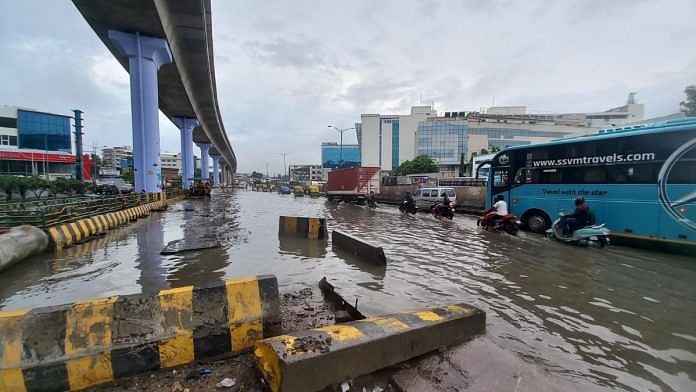Thank you dear subscribers, we are overwhelmed with your response.
Your Turn is a unique section from ThePrint featuring points of view from its subscribers. If you are a subscriber, have a point of view, please send it to us. If not, do subscribe here: https://theprint.in/subscribe/
- Frequent Flooding of Cities:
With climate change, it has now become seemingly impossible problem to solve. The existing drainage systems cannot manage. We need some out of box solution to address this issue. Let us introduce rainwater recharge pits, in a very large scale, so that the water goes into the ground locally, as much as possible. For that, all government institutions with certain minimum ground area, say half-acre or more, should be mandated to have sufficient recharge holes, such that no water comes out of their premises, even if it rains heavily for three hours. Similarly, all public grounds & gardens. In addition, it should be made mandatory for every road to have sufficient recharge pits, to prevent flooding. Yes, these recharge pits should be designed in such a way that water goes downward and waste & sediments aggregate by the side, for easy clearance of such waste, to prevent clogging. One suggestion could be to cover the recharge pits with a rust free semi-spherical domes, which permits only water and sand inside. A net inside can collect the sand for frequent disposal and in turn permitting only water into the pits. When implemented, this scheme has the potential to indirectly help improve the water tables in cities, which are ever depleting due to large scale bore water usage. With proper implementation of the scheme, Flooding of the cities will get considerably mitigated. In turn, the damage to roads due to rains. The cost of implementation will be relatively less to civic bodies, as compared to what they save in reccuring repair of roads.
- How to bringing in a better system for maintenance of city roads:
There appears to be never ending complaints on pot holes etc on city roads and consequent seasonal repairs every year, leading to wasteful spending. Instead, it is suggested that we go for a 5-7 year Road Repair and Maintenance Contracts, which has a cost for initial road repairs and another cost for subsequent annual maintenance (AMC), with an automatic 5-6% escalation per year. To ensure quality, the contractor should give a BG covering the initial repairs, valid for two years. Subsequently, it can be reduced to twice the annual maintenance cost, but valid for the rest of the contract. Twice the maintenance cost to ensure sufficient commitment and also cover the increase due to the annual escalations. For each stretch of the road, let us create a WhatsApp complaint number for people to report the road condition requiring repair by a photo/video. The civic authority should assign another private agency to maintain the log of these WhatsApp complaints, in terms of date of Complaint Number, the date of its closure and whether it is repeating. A monthly summary report should be submitted to the local civic authority, responsible for the AMC payments. Quarterly payments of AMC should be paid, if there is no complaint still pending from the previous quarter (which means a maximum three month leeway) and also not more than 25% complaints still to be addressed in the current quarter.
- Traffic Congestion in Ring Roads of Metropolitan Cities such as Bangalore:
For example, the Outer Ring Road of Bangalore which is the main artery of Bangalore is getting heavily congested these days, in spite of six lanes. Similar issue is not arising in Hyderabad, where they have gone for twelve lanes. It is almost impossible to widen the Outer Ring Road of Bangalore, given the high cost of real estate, that is already in place. Hence, this suggestion, taking clue from the fact that Outer Ring Road metro is built on a flyover, built on the pillars over the median.
It is suggested that similar flyovers be built on either side of the ring road, covering the Service Road and the left most lane. The flyovers should be as wide as possible, with atleast minimum of two lanes. The pillars can be placed between the Service Road and left most lane. They should be sufficiently high to clear the existing foot over bridges and also for lorry traffic which requires higher clearance. These new fly overs be treated as express lanes and charged for their use. Once implemented, they should help relieve the traffic considerably. Let us go in for them throughout the length of ring road with high traffic. These flyovers will be tall enough to allow sufficient ventilation for the traffic at ground level.
- Interlinking of Southern Rivers:
Thanks to the initiative of AP government, there is now a proposal for a Banakacharla project, moving Godavari water up to Krishna and Penna rivers, given the tremendous excess water flowing into see. Since the AP government is seeking for its approval as a central project, the central government may use the opportunity to expand the scope of the project and extend it right up to Cauveri River, addressing most of the water shortages in South. It will be an economically viable and a very useful link to implement. It will also give an impetus to the long pending concept of inter linking of rivers in the country.
Dr K Sham Sunder
Outstanding Scientist & a former Project Director of ADA
These pieces are being published as they have been received – they have not been edited/fact-checked by ThePrint.


